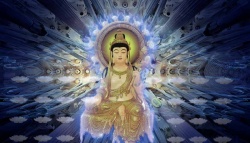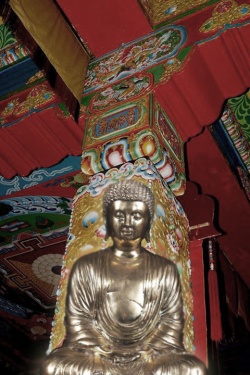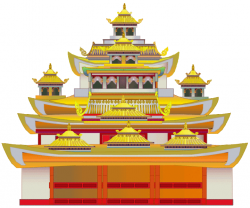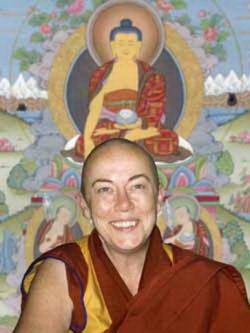Tantric Imagery
Survey of the Misunderstanding
One of the more perplexing and most easily misunderstood aspects of tantra is its imagery suggestive of sex, devil-worship, and violence. Buddha-figures often appear as couples in union and many have demonic faces, stand enveloped in flames, and trample helpless beings beneath their feet. Seeing these images horrified early Western scholars, who often came from Victorian or missionary backgrounds.
Even nowadays, some people believe that the couples signify the sexual exploitation of women. Others imagine that couples in union represent the transcendence of all duality to the point that there is no difference between "good" and "bad." They think that, consequently, tantra is immoral and not only sanctions, but even encourages usage of alcohol and drugs, and hedonistic, criminal, and despotic behavior. Some go as far as accusing well-respected tantric masters of plotting to take over the world.
Westerners were not the first to declare tantra a degenerate form of Buddhism. When tantra originally came to Tibet in the mid-eighth century, many took the imagery literally as granting free license to ritual sex and blood sacrifice. Subsequently, in the early ninth century, a religious council banned further official translation of tantra texts and prohibited the inclusion of tantra terminology in its Great (Sanskrit-Tibetan) Dictionary. One of the main incentives for the Tibetans' inviting Indian masters for the second spread of Buddhism in Tibet was to clarify misunderstanding about sex and violence in tantra.
Not all Westerners who had early contact with tantra found the imagery depraved. A number misunderstood it in other ways. Some, for example, felt that the sexual imagery symbolized the psychological process of integrating the masculine and feminine principles within each person. Others, like many early Tibetans, found the images erotic. Even now, some people turn to tantra hoping to find new and exotic sexual techniques or spiritual justification for their obsession with sex. Still others found the terrifying figures alluring for their promise of granting extraordinary powers. Such people followed in the footsteps of the thirteenth-century Mongol conqueror Kublai Khan, who adopted Tibetan tantra primarily in the wish that it would help him gain victory over his foes.
Misunderstanding about tantra, then, is a perennial problem. The reason for tantra's insistence on secrecy about its teachings and images is to avoid such misconceptions, not to hide something perverse. Only those with sufficient preparation in study and meditation have the background to understand tantra within its proper context.
Couples in Union
Raising to consciousness and integrating the masculine and feminine principles are important and helpful parts of the path to psychological maturity as taught by several therapeutic schools based on the works of Jung. To ascribe Buddhist tantra as an ancient source of this approach, however, is an interpolation. The misunderstanding comes from seeing Buddha-figures as couples in union and incorrectly translating the Tibetan words for the couple, yab-yum, as male and female. The words actually mean father and mother. Just as a father and mother in union are required for producing a child, likewise method and wisdom in union are required for giving birth to enlightenment.
Method, the father, stands for bodhichitta and various other causes taught in tantra for gaining the enlightening physical bodies of a Buddha or a Buddha's omniscient awareness of conventional truth. Wisdom, the mother, stands for the realization of voidness with various levels of mind, as causes for a Buddha's enlightening mind or a Buddha's omniscient awareness of deepest truth. Gaining the union of a Buddha's physical bodies and mind or a Buddha's omniscient awareness of the conventional and deepest truths of all things requires practicing a union of method and wisdom. Because traditional Indian and Tibetan cultures do not share a Biblical sense of prudishness about sex, they do not have taboos about using sexual imagery to symbolize this union.
One level of meaning of father as method is blissful awareness. The union of father and mother signifies blissful awareness conjoined with the realization of voidness – in other words, the realization or understanding of voidness with a blissful awareness. Here, blissful awareness does not refer to the bliss of orgasmic release as in ordinary sex, but to a blissful state of mind achieved through advanced yoga methods for bringing the energy-winds (lung, rlung; Skt. prana) into the central energy-channel. A prolonged succession of moments of such a mental state is conducive for reaching the subtlest level of the mental continuum, one's clear light continuum – the most efficient level of experiencing for realizing voidness. The embrace of father and mother, then, also symbolizes the blissful aspect of the union of method and wisdom, but in no way signifies the use of ordinary sex as a tantra method.
In the final stages of the path of the highest class of tantra, the advanced yoga methods for drawing the energy-winds into the central channel do entail a man and woman sitting in a posture of union. Far from being exploitative, however, both partners are required to have reached the same advanced level of spiritual development. This includes both having reached the level of control of their subtle energies and their minds so that even though the bottom tips of their central channels touch, both avoid orgasmic release.
Sitting in such a yogic posture while engaging in complex visualizations and meditating on voidness is only done to enhance the practice on the most advanced levels. It is not done as the main practice or engaged in regularly, and is certainly not a practice for earlier stages of the path.
Moreover, to avoid any possibility of misogyny, machismo, or male chauvinism, one of the tantric vows is to refrain from ever speaking badly or mistreating women.
Every tantric initiation requires the taking of vows to refrain from destructive behavior. In all classes of tantra, practitioners take the bodhisattva vows to refrain from behavior that would either harm others or damage their abilities to help others. The required foundation is having taken refuge (having put a safe direction in their lives) and upholding some level of lay or monastic vow, such as refraining from taking life, stealing, lying, engaging in inappropriate sexual behavior, and taking intoxicants. Initiation into the two highest classes of tantra also requires taking the tantric vows, to refrain from behaving in ways that would damage their spiritual progress, such as neglecting to remain mindful of voidness each day.
Voidness does not mean that everything, including ethics, in actuality do not exist. It never negates the conventional distinctions between destructive and constructive behavior, or the functioning of behavioral cause and effect. Nonduality, as represented by couples in union, means that categories such as "destructive" and "constructive" do not exist independently of each other. They are designated in relation to each other and in relation to their causes and effects. Thus, going beyond dualism does not mean gaining authority for indulging in selfish or exploitative behavior and for abrogating responsibility for one's actions. It means gaining awareness of the totality of reality, with a vision of the interrelatedness and interdependence of everything.
Moreover, when tantric practitioners accept a small taste of specially consecrated alcohol and meat during certain rituals, this symbolizes the purification and usage of the subtle energies in their bodies for reaching enlightenment. As in the taking of specially consecrated bread and wine during a Christian communion, the symbolic act hardly sanctions alcohol or drug abuse.
Peaceful and Forceful Figures
Buddha-figures may be peaceful or forceful, as indicated on the simplest level by their having smiles on their faces or fangs bared. More elaborately, forceful figures have terrifying faces, hold an arsenal of weapons, and stand surrounded by flames. Descriptions of them specify in gory detail various ways in which they smash their enemies. Part of the confusion that arises about the role and intent of these forceful figures comes from the usual translations of the word for them, trowo (khro-bo, Skt. krodha), as angry or wrathful deities.
For many Westerners with a Biblical upbringing, the term wrathful deity carries the connotation of an almighty being with righteous vengeful anger. Such a being metes out divine punishment as retribution for evildoers who have disobeyed its laws or somehow offended it. For some people, a wrathful deity may even connote the Devil or a demon working on the side of darkness. The Buddhist concept has nothing to do with such notions. Although the Tibetan term derives from one of the usual words for anger, anger here has more the connotation of repulsion – a rough state of mind directed toward an object with the wish to get rid of it. Thus, a more appropriate translation for "trowo" might be a forceful figure.
Forceful figures symbolize the strong energetic means often required to break through mental and emotional blocks that prevent one from being clearheaded or compassionate. The enemies the figures smash include dullness, laziness, and self-centeredness. The weapons they use span positive qualities developed along the spiritual path, such as concentration, enthusiasm, and love. The flames that surround them are the different types of deep awareness (yeshey, ye-shes; Skt. jnana, wisdom) that burn away obscurations. Imagining oneself as a forceful figure helps to harness the mental energy and resolve to overcome "internal enemies."
From the Buddhist perspective, the subtlest energy of the clear light continuum may be peaceful or forceful. When associated with confusion, the peaceful and forceful energies and the emotional states that they underlie become destructive. For example, peaceful energy becomes lethargic and forceful energy becomes angry and violent. When rid of confusion, the energies may readily combine with concentration and discriminating awareness (sherab, shes-rab; Skt. prajna, wisdom), so that they are available for positive, constructive use. With peaceful energy, one may calm oneself and others to deal with difficulties in a levelheaded manner. With forceful energy, one may rouse oneself and others to have more strength, courage, and intensity of mind to overcome dangerous situations.
Concluding Remarks
Contemporary Western advertising and entertainment draw their success partially from most people's fascination with sex and violence. For some persons, this fascination also attracts them to tantra. Their attraction, however, may lead them to higher aims.
In general, watching, hearing about, or engaging in sex and violence excites people's energies. Hormones flow and the mind becomes intense. The violence need not be gory, but may include extreme or contact sports. Some people, of course, experience aversion or are so jaded by such things that they feel nothing. Consider, however, those who become fascinated or obsessed. If confusion accompanies the energies aroused by their passions, such people may cause problems for themselves or others, for example by being rowdy. If, on the other hand, people accompany the energies with mindfulness, concentration, and insight, they may transform and use the energies for positive aims. Tantra provides skillful methods for bringing about the transformation, specifically for the sake of helping others. To derive the full benefits of tantra practice, however, requires deeper understanding of the processes involved.




